RF I/O and Switching Introduction
General
The RXTX Ensemble board with a date of 4/4/10 had a wiring error concerning the point in the circuit where the RX BPF antenna connection is made.
The author got caught by this and reinstalled C27 to the underside of the board (shown in the bottom view of the completd board . Production boards will not have this problem.
Here is a sketch provided courtesy of Bob, G8VOI. On 20 March 2011, supporting the following description:
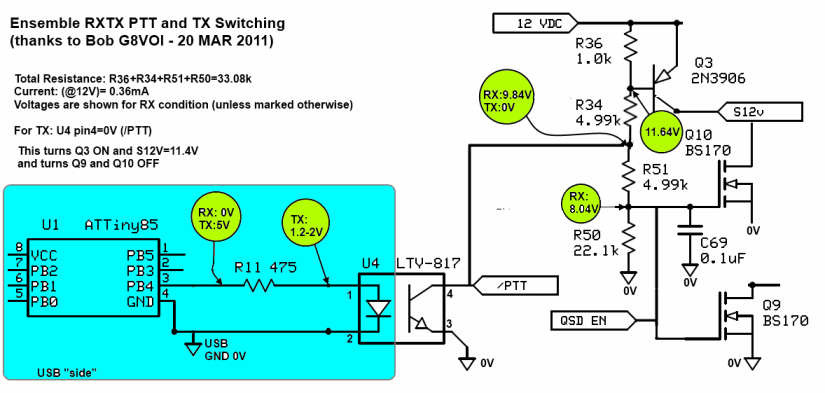
This stage handles the RF input and Output paths, along with the switching from Receive to Transmit. The radio defaults to the RX mode. When a PTT signal is sent down the USB line to the ATTiny 85 in the Local Oscillator stage, that signal is passed through to the radio across the galvanically isolated boundary beteen the digital and analog side of the rig via the optoisolator, U4.
In RX the /PTT line is pulled toward 12 volts which results in Q10 conducting RX signal and Q9 pulling the /OE pins of U10 low to enable the QSD operation.
In TX the /PTT line is pulled low by optoisolator U4 and Q9 and Q10 are not conducting. This results in Q11 conducting and shorting the RX input to ground. It also results in pulling the base of Q3 down, turning it on and generating the S12V supply to the PA on transmit.
This allows the rig to use the path to the antenna jack by RX and TX. As a matter of convenience, we install all of that path in this stage.
This stage includes winding a toroidal transformer and three toroidal coils. The builder needs to be very careful to note the toroid requirements, which are band-specific. Be sure to use the right toroid, as indicated in the Bill of Materials. Check:
- The color: "Tnn-2" is red; "Tnn-6" is yellow)
- The size: "T25-n" is a 0.25" OD toroid; T30-n" is a 0.30" OD toroid; and "T37-n" is 0.37"
If you have no experience with winding and installing toroidal inductors, you are strongly encouraged to review the WB5RVZ Instructions for Winding and Installing such inductors.
(go directly to build notes)RF I/O and Switching Schematic
(Resistor testpoints (hairpin, top, or left-hand lead), as physically installed on the board, are marked in the schematic with red dots)
(Click for Full Schematic)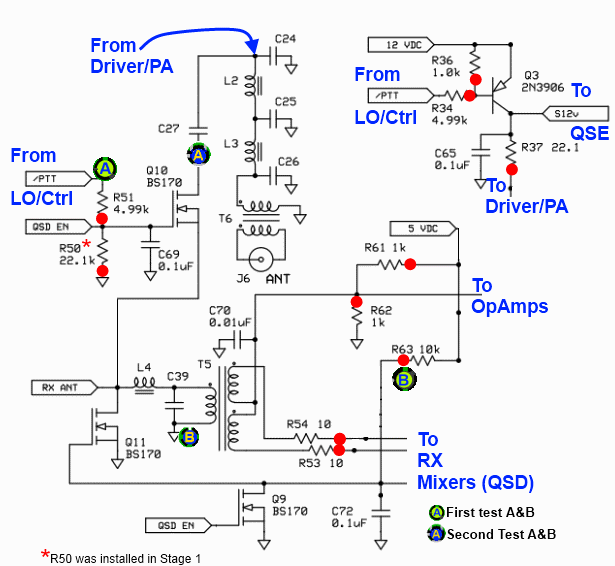
(above schematic has clickable areas that can be used for navigation)
(go directly to build notes)RF I/O and Switching Bill of Materials
Stage Bill of Materials
(resistor images and color codes courtesy of WIlfried, DL5SWB's R-Color Code program)
| Check | Count | Component | Marking | Category |
|---|---|---|---|---|
| ❏ | 3 | 1 k 1/4W 1% | br-blk-blk-br-br
 | 1/4W |
| ❏ | 1 | 10 k 1/4W 1% | br-blk-blk-r-br
 | 1/4W |
| ❏ | 2 | 10 ohm 1/4W 1% | br-blk-blk-gld-br
 | 1/4W |
| ❏ | 1 | 22.1 ohm 1% | red-red-brn-gld-brn
 | 1/4W |
| ❏ | 2 | 4.99 k 1/4W 1% | y-w-w-br-br
 | 1/4W |
| ❏ | 1 | bnc connector pcb (rt-angle) |
 | BNC-RA |
| ❏ | 15 | band-specific | misc | |
| ❏ | 1 | 0.01 uF | (smt)
 | SMT 1206 |
| ❏ | 3 | 0.1 uF | (smt) black stripe
 | SMT 1206 |
| ❏ | 1 | 2N3906 PNP transistor | 2N3906
 | TO-92 |
| ❏ | 3 | BS170 N-Channel Enhancement Mode FET | BS170
 | TO-92 |
Band Specific Items for 160m Band
| Check | Designation | Component | Marking | Category | Orientation | Notes | Circuit |
|---|---|---|---|---|---|---|---|
| ❏ | C24 | 2200 pF 5% | 222 | Ceramic | RF I/O and Switching | ||
| ❏ | C25 | 4700 pF 5% | 472 | Ceramic | RF I/O and Switching | ||
| ❏ | C26 | 2200 pF 5% | 222 | Ceramic | RF I/O and Switching | ||
| ❏ | C27 | 390 pF 5% | 391
 | Ceramic | RF I/O and Switching | ||
| ❏ | C39 | 5600 pF 5% | 562 | Ceramic | RF I/O and Switching | ||
| ❏ | L2 | 3.4 uH: 29T #26 on T37-2 (red) (17") | red
 | Coil | RF I/O and Switching | ||
| ❏ | L2core | T37-2 toroid core | red
 | Toroid | RF I/O and Switching | ||
| ❏ | L3 | 3.4 uH: 29T #26 on T37-2 (red) (17") | red
 | Coil | RF I/O and Switching | ||
| ❏ | L3core | T37-2 toroid core | red
 | Toroid | RF I/O and Switching | ||
| ❏ | L4 | 18.7 uH: 66T #30 on T30-2 (red) (35") | red
 | Coil | RF I/O and Switching | ||
| ❏ | L4core | T30-2 toroid core | red
 | Toroid | RF I/O and Switching | ||
| ❏ | T5 | 1.4 uH: 18T/2x9T bifilar #30 on T30-2 (red) 11" | red
 | Xfrmr | RF I/O and Switching | ||
| ❏ | T5core | T30-2 toroid core | red
 | Toroid | RF I/O and Switching | ||
| ❏ | T6 | 4T bifilar #30 on BN-43-2402 (9") |
 | xfrmr | RF I/O and Switching | ||
| ❏ | T6core | BN-43-2402 (no markings!) | none
 | Binocular core | RF I/O and Switching |
Band Specific Items for 80, 40m Band
| Check | Designation | Component | Marking | Category | Orientation | Notes | Circuit |
|---|---|---|---|---|---|---|---|
| ❏ | C24 | 470 pF 5% | 471 | Ceramic | RF I/O and Switching | ||
| ❏ | C25 | 820 pF 5% | 821 | Ceramic | RF I/O and Switching | ||
| ❏ | C26 | 470 pF 5% | 471 | Ceramic | RF I/O and Switching | ||
| ❏ | C27 | 560 pF | 561 | Ceramic | RF I/O and Switching | ||
| ❏ | C39 | 680 pF 5% | 681
 | Ceramic | RF I/O and Switching | ||
| ❏ | L2 | 1.4 uH: 19T #26 on T37-2 (red) 12" | red
 | Coil | RF I/O and Switching | ||
| ❏ | L2core | T37-2 toroid core | red
 | Toroid | RF I/O and Switching | ||
| ❏ | L3 | 1.4 uH: 19T #26 on T37-2 (red) 12" | red
 | Coil | RF I/O and Switching | ||
| ❏ | L3core | T37-2 toroid core | red
 | Toroid | RF I/O and Switching | ||
| ❏ | L4 | 1.6 uH: 22T #30 on T25-2 (red) (10") | red
 | Coil | RF I/O and Switching | ||
| ❏ | L4core | T25-2 toroid core | red
 | Toroid | RF I/O and Switching | ||
| ❏ | T5 | 1.2 uH: 18T/2x9T bifilar #30 on T25-2 (red) 9" | red
 | Xfrmr | RF I/O and Switching | ||
| ❏ | T5core | T25-2 toroid core | red
 | Toroid | RF I/O and Switching | ||
| ❏ | T6 | 4T bifilar #30 on BN-43-2402 (9") |
 | xfrmr | RF I/O and Switching | ||
| ❏ | T6core | BN-43-2402 (no markings!) | none
 | Binocular core | RF I/O and Switching |
Band Specific Items for 40, 30, 20m Band
| Check | Designation | Component | Marking | Category | Orientation | Notes | Circuit |
|---|---|---|---|---|---|---|---|
| ❏ | C24 | 220 pF 5% | 221
 | Ceramic | RF I/O and Switching | ||
| ❏ | C25 | 470 pF 5% | 471 | Ceramic | RF I/O and Switching | ||
| ❏ | C26 | 220 pF 5% | 221
 | Ceramic | RF I/O and Switching | ||
| ❏ | C27 | 330 pF 5% | 331
 | Ceramic | RF I/O and Switching | ||
| ❏ | C39 | 470 pF 5% | 471 | Ceramic | RF I/O and Switching | ||
| ❏ | L2 | 0.8 uH: 16T #26 on T37-6 (yellow) (11") | yellow
 | Coil | RF I/O and Switching | ||
| ❏ | L2core | T37-6 toroid core | yellow
 | Toroid | RF I/O and Switching | ||
| ❏ | L3 | 0.8 uH: 16T #26 on T37-6 (yellow) (11") | yellow
 | Coil | RF I/O and Switching | ||
| ❏ | L3core | T37-6 toroid core | yellow
 | Toroid | RF I/O and Switching | ||
| ❏ | L4 | 0.9uH 18T #30 on T25-6(yellow) (10") | yellow
 | Coil | RF I/O and Switching | ||
| ❏ | L4core | T25-6 toroid core | yellow
 | Toroid | RF I/O and Switching | ||
| ❏ | T5 | 0.69 uH: 16T/2x8T bifilar #30 on T25-6 (yellow) 9" | yellow
 | Xfrmr | RF I/O and Switching | ||
| ❏ | T5core | T25-6 toroid core | yellow
 | Toroid | RF I/O and Switching | ||
| ❏ | T6 | 4T bifilar #30 on BN-61-2402 (9") |
 | xfrmr | RF I/O and Switching | ||
| ❏ | T6core | BN-61-2402 (no Markings!) | none
 | Binocular core | RF I/O and Switching |
Band Specific Items for 30, 20, 17m Band
| Check | Designation | Component | Marking | Category | Orientation | Notes | Circuit |
|---|---|---|---|---|---|---|---|
| ❏ | C24 | 150 pF 5% | 151 (may be blue or tan)
 | Ceramic | RF I/O and Switching | ||
| ❏ | C25 | 330 pF 5% | 331
 | Ceramic | RF I/O and Switching | ||
| ❏ | C26 | 150 pF 5% | 151 (may be blue or tan)
 | Ceramic | RF I/O and Switching | ||
| ❏ | C27 | 180 pF 5% | 181
 | Ceramic | RF I/O and Switching | ||
| ❏ | C39 | 220 pF 5% | 221
 | Ceramic | RF I/O and Switching | ||
| ❏ | L2 | 0.6 uH: 14T #26 on T37-6 (yellow) (10") | yellow
 | Coil | RF I/O and Switching | ||
| ❏ | L2core | T37-6 toroid core | yellow
 | Toroid | RF I/O and Switching | ||
| ❏ | L3 | 0.6 uH: 14T #26 on T37-6 (yellow) (10") | yellow
 | Coil | RF I/O and Switching | ||
| ❏ | L3core | T37-6 toroid core | yellow
 | Toroid | RF I/O and Switching | ||
| ❏ | L4 | 0.78 uH 17T #30 on T25-6 (yellow) (8") | yellow
 | Coil | RF I/O and Switching | ||
| ❏ | L4core | T25-6 toroid core | yellow
 | Toroid | RF I/O and Switching | ||
| ❏ | T5 | 0.6 uH: 14T/2x7T bifilar #30 on T25-6 (yellow) 8" | yellow
 | Xfrmr | RF I/O and Switching | ||
| ❏ | T5core | T25-6 toroid core | yellow
 | Toroid | RF I/O and Switching | ||
| ❏ | T6 | 4T bifilar #30 on BN-61-2402 (9") |
 | xfrmr | RF I/O and Switching | ||
| ❏ | T6core | BN-61-2402 (no Markings!) | none
 | Binocular core | RF I/O and Switching |
Band Specific Items for 15, 12, 10m Band
| Check | Designation | Component | Marking | Category | Orientation | Notes | Circuit |
|---|---|---|---|---|---|---|---|
| ❏ | C24 | 100 pF 5% | 101
 | Ceramic | RF I/O and Switching | ||
| ❏ | C25 | 180 pF 5% | 181
 | Ceramic | RF I/O and Switching | ||
| ❏ | C26 | 100 pF 5% | 101
 | Ceramic | RF I/O and Switching | ||
| ❏ | C27 | 82 pF | 82J
 | Ceramic | RF I/O and Switching | ||
| ❏ | C39 | 330 pF 5% | 331
 | Ceramic | RF I/O and Switching | ||
| ❏ | L2 | 0.36 uH: 11T #26 (9") on T37-6 (yellow) | yellow
 | Coil | RF I/O and Switching | ||
| ❏ | L2core | T37-6 toroid core | yellow
 | Toroid | RF I/O and Switching | ||
| ❏ | L3 | 0.36 uH: 11T #26 (9") on T37-6 (yellow) | yellow
 | Coil | RF I/O and Switching | ||
| ❏ | L3core | T37-6 toroid core | yellow
 | Toroid | RF I/O and Switching | ||
| ❏ | L4 | 0.53 uH 14T #30 on T25-6 (10") | yellow
 | Coil | RF I/O and Switching | ||
| ❏ | L4core | T25-6 toroid core | yellow
 | Toroid | RF I/O and Switching | ||
| ❏ | T5 | 0.13 uH: 7T/2x4T bifilar #30 on T25-6 (yellow) 5" | yellow
 | Xfrmr | RF I/O and Switching | ||
| ❏ | T5core | T25-6 toroid core | yellow
 | Toroid | RF I/O and Switching | ||
| ❏ | T6 | 4T bifilar #30 on BN-61-2402 (9") |
 | xfrmr | RF I/O and Switching | ||
| ❏ | T6core | BN-61-2402 (no Markings!) | none
 | Binocular core | RF I/O and Switching |
RF I/O and Switching Summary Build Notes
- Install SMT Capacitors
- Wind and Install Coils
- Wind and Install Transformers
- Install Topside Transistors
- Install Band-Specific Capacitors
- Install Topside Resistors
- Install BNC Connector
- Test the Stage
RF I/O and Switching Detailed Build Notes
Bottom of the Board
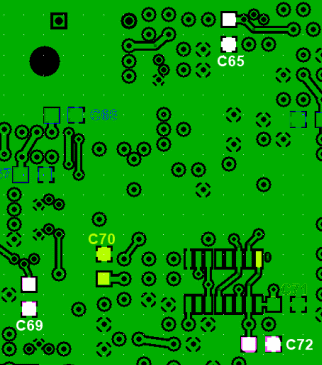
Install SMT Capacitors
| Check | Designation | Component | Marking | Category | Orientation | Notes |
|---|---|---|---|---|---|---|
| ❏ | C70 | 0.01 uF | (smt)
 | SMT 1206 | ||
| ❏ | C65 | 0.1 uF | (smt) black stripe
 | SMT 1206 | ||
| ❏ | C69 | 0.1 uF | (smt) black stripe
 | SMT 1206 | ||
| ❏ | C72 | 0.1 uF | (smt) black stripe
 | SMT 1206 |
Top of the Board
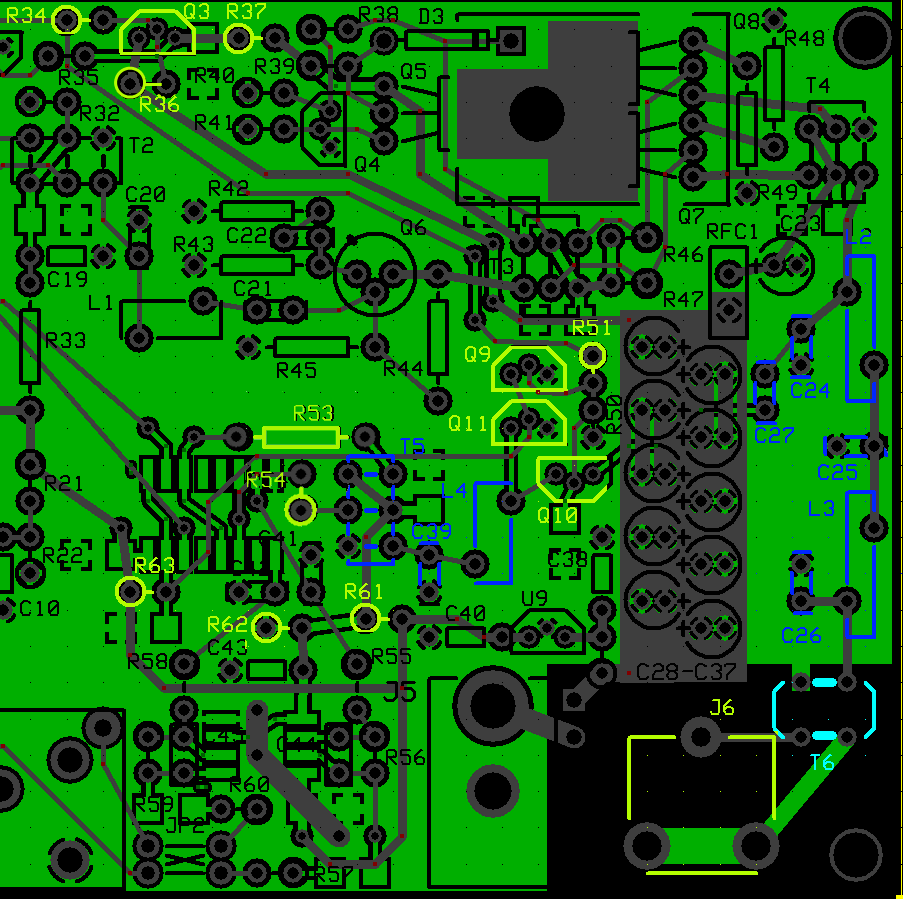
Wind and Install Coils
Wind and install each of the three coils. Recall that any pass of the wire through the toroid's core counts as ONE turn. Refer to the WB5RVZ coil winding instructions for details on how to wind and prepare/install single-winding coils.
Once you have installed the the coils (L2 and L3 and L4), you can test your soldering by checking the continuity of the winding for each coil as follows (using points on traces connecting the coils to other components - these tests are most easily done PRIOR to installing the remaining components in this stage):
| Coil | First Point | Second Point |
|---|---|---|
| L2 | C27(top) | C25 (right) |
| L3 | C25 (right) | C26 (bottom) |
| L4 | Top C27 (leftmost hole) | C39 (top) (note Power must be on and transistors installed.) |
Note: L4 is switched on. You will need to power the board and let the switching transistors provide continuity on the path to/through L4.
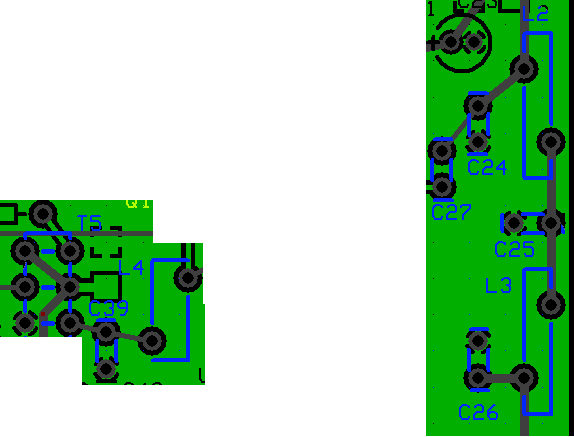
| Check | Designation | Component | Marking | Category | Orientation | Notes | ||||||||||||||||||
|---|---|---|---|---|---|---|---|---|---|---|---|---|---|---|---|---|---|---|---|---|---|---|---|---|
| ❏ | L2 | band-specific |
| misc | ||||||||||||||||||||
| ❏ | L2core | band-specific | misc | |||||||||||||||||||||
| ❏ | L3 | band-specific |
| misc | ||||||||||||||||||||
| ❏ | L3core | band-specific | misc | |||||||||||||||||||||
| ❏ | L4 | band-specific |
| misc | ||||||||||||||||||||
| ❏ | L4core | band-specific | misc |
Wind and Install Transformers
Wind and install toroidal transformers T5 and T6. See the WB5RVZ Instructions for Toroidal Transformers for important, detailed instructions on how to wind and install toroidal transformers..
After installing the transformers, you should check the primary and secondary windings for continuity with your ohmmeter, using the following testpoints connected via traces to the windings (these tests are easier done prior to installing the remaining components in this stage):
| Coil | First Point | Second Point |
|---|---|---|
| T5 Primary | C39 (left) | C39 (right) |
| T5 Secondaries | R53 (right) | R54 (bottom) |
| T6 Secondary | C26 (bottom) | C26 (top) |
| T6 Primary | Center conductor of J6 | Shield side of J6 |
If you are unfamiliar with winding and installing inductors, you may want to refer to the WB5RVZ construction hints for coils (toroidal) and transformers ( toroidal and binocular). Click here for details on identifying toroid cores.
Decoding the trqansformer specifications:
Transformers' windings are specified using the pattern "nnT/wXmmT" or "wXmmT/nnT", where:
- "nn" is the number of turns in the single winding
- "mm" is the number of turns in the multiple windings
- "w" = the number of multiple windings (e.g., 2 = bifilar; 3 = trifilar, etc.)
Thus, e.g., "18T/2x9T bifilar #30" means, using #30 wire, produce a single 18 turn primary winding and two 9-turn secondary windings; "2x9T bifilar/ 18T #30" means, using #30 wire, produce two 9-turn primary windings and a single 18 turn secondary winding.
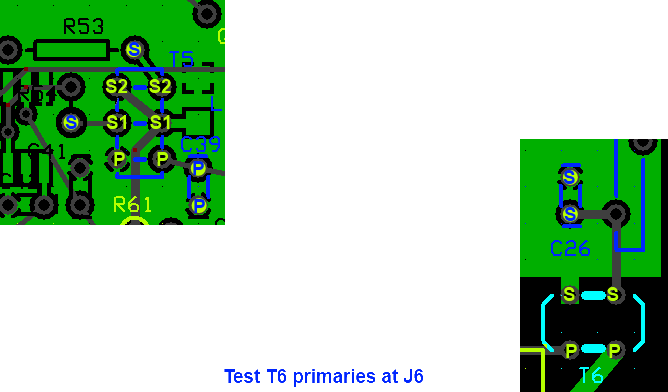
| Check | Designation | Component | Marking | Category | Orientation | Notes | ||||||||||||||||||
|---|---|---|---|---|---|---|---|---|---|---|---|---|---|---|---|---|---|---|---|---|---|---|---|---|
| ❏ | T5 | band-specific |
| misc | ||||||||||||||||||||
| ❏ | T5core | band-specific | misc | |||||||||||||||||||||
| ❏ | T6 | band-specific |
| misc | ||||||||||||||||||||
| ❏ | T6core | band-specific | misc |
Install Topside Transistors
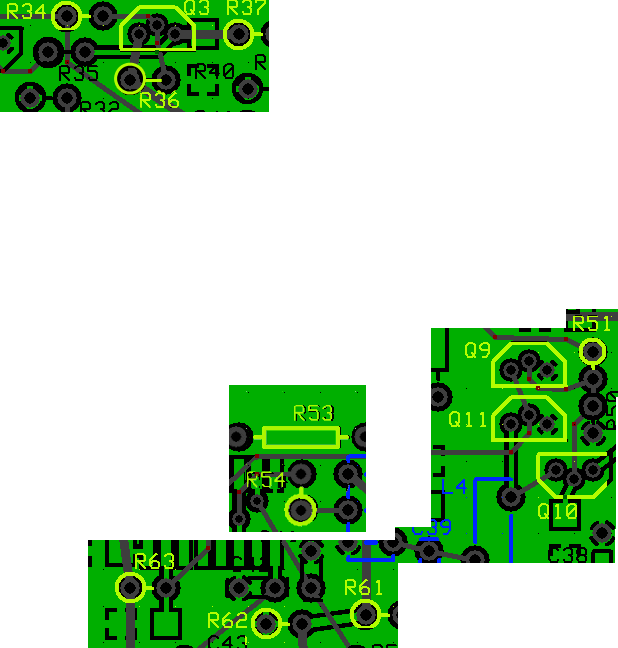
| Check | Designation | Component | Marking | Category | Orientation | Notes |
|---|---|---|---|---|---|---|
| ❏ | Q03 | 2N3906 PNP transistor | 2N3906
 | TO-92 | ||
| ❏ | Q09 | BS170 N-Channel Enhancement Mode FET | BS170
 | TO-92 | Take ESD precautions | |
| ❏ | Q10 | BS170 N-Channel Enhancement Mode FET | BS170
 | TO-92 | Take ESD precautions | |
| ❏ | Q11 | BS170 N-Channel Enhancement Mode FET | BS170
 | TO-92 | Take ESD precautions |
Install Band-Specific Capacitors

| Check | Designation | Component | Marking | Category | Orientation | Notes | ||||||||||||||||||
|---|---|---|---|---|---|---|---|---|---|---|---|---|---|---|---|---|---|---|---|---|---|---|---|---|
| ❏ | C24 | band-specific |
| misc | ||||||||||||||||||||
| ❏ | C25 | band-specific |
| misc | ||||||||||||||||||||
| ❏ | C26 | band-specific |
| misc | ||||||||||||||||||||
| ❏ | C27 | band-specific |
| misc | ||||||||||||||||||||
| ❏ | C39 | band-specific |
| misc |
Install Topside Resistors

| Check | Designation | Component | Marking | Category | Orientation | Notes |
|---|---|---|---|---|---|---|
| ❏ | R53 | 10 ohm 1/4W 1% | br-blk-blk-gld-br
 | 1/4W | flat-horiz | |
| ❏ | R54 | 10 ohm 1/4W 1% | br-blk-blk-gld-br
 | 1/4W | S-N | |
| ❏ | R37 | 22.1 ohm 1% | red-red-brn-gld-brn
 | 1/4W | W-E | |
| ❏ | R36 | 1 k 1/4W 1% | br-blk-blk-br-br
 | 1/4W | W-E | |
| ❏ | R61 | 1 k 1/4W 1% | br-blk-blk-br-br
 | 1/4W | W-E | |
| ❏ | R62 | 1 k 1/4W 1% | br-blk-blk-br-br
 | 1/4W | W-E | |
| ❏ | R34 | 4.99 k 1/4W 1% | y-w-w-br-br
 | 1/4W | W-E | |
| ❏ | R51 | 4.99 k 1/4W 1% | y-w-w-br-br
 | 1/4W | N-S | |
| ❏ | R63 | 10 k 1/4W 1% | br-blk-blk-r-br
 | 1/4W | W-E |
Install BNC Connector
| Check | Designation | Component | Marking | Category | Orientation | Notes |
|---|---|---|---|---|---|---|
| ❏ | J6 | bnc connector pcb (rt-angle) |
 | BNC-RA |
RF I/O and Switching Completed Stage
Author inadvertently left R53 and R54 out of the completed board in this phase. Those components should actually be installed in this phase.
Also, there is a "patch" shown on the bottom view necessitated by the fact that the author's board was a prototype and had incorrect mounting for C27. This should not bother builders using the production boards.
Top of the Board
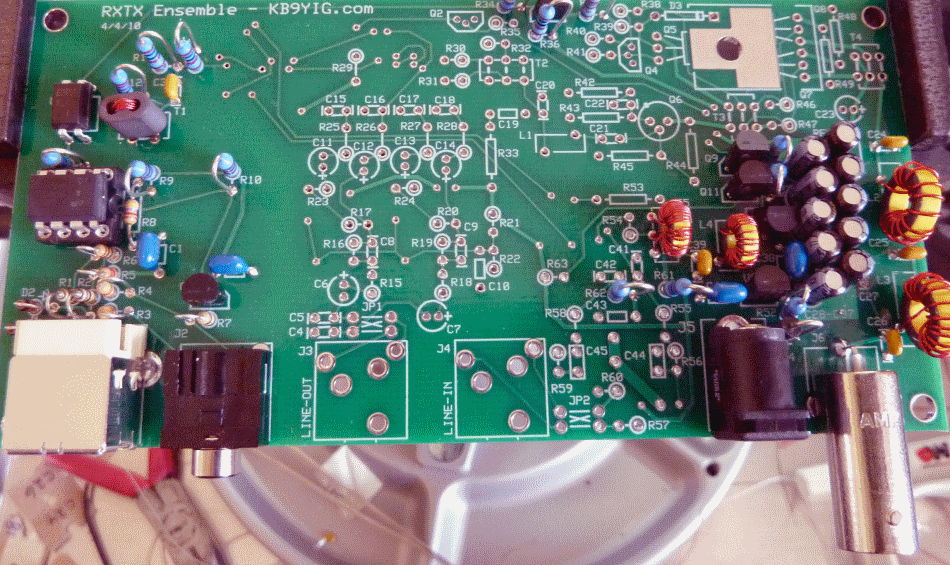
Bottom of the Board
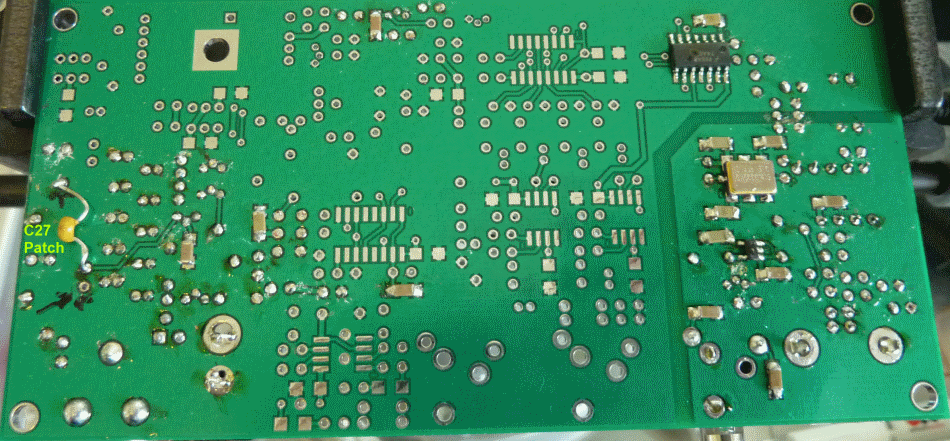
RF I/O and Switching Testing
Current Draw
Test Setup
Power up the board and check the current draw
Test Measurements
| Testpoint | Units | Nominal Value | Author's | Yours |
|---|---|---|---|---|
| Current draw | mA | <20 | 16.1 | _______ |
Voltage Divider Test
Test Setup
R61 and R62 form a voltage divider off of the 5 volt rail.
The output of that voltage divider go to the secondary windings of T5 to Resistors R53 and R54
Apply 12V power to the board and measure the voltage at the hairpin lead of R62.
Test Measurements
| Testpoint | Units | Nominal Value | Author's | Yours |
|---|---|---|---|---|
| R62 hairpin lead (wrt regular ground) (with V+ = 12.7V) | Vdc | 2.5 | 2.48 | _______ |
| R53 left lead (wrt regular ground) | Vdc | 2.5 | tbd | _______ |
| R54 hairpin lead (wrt regular ground) | Vdc | 2.5 | tbd | _______ |
RF Switching Testing
Test Setup
Voltages are measured WRT (regular) ground (R50 hairpin)
Test the PTT switching from the default RX/QSD enabled to the switched TX/QSE enabled.
Requires USB connected and 13V power applied to the board.
Test for default (RX) and then use SDR Software to activate PTT and test for QSD disabled OFF.
 (As an alternative to using the SDR Software to activate PTT, you can use a cliplead to ground the top left-hand lead of U4, activating PTT.)
(As an alternative to using the SDR Software to activate PTT, you can use a cliplead to ground the top left-hand lead of U4, activating PTT.)
Enabling PTT also should pull the base of Q3 down, turning it on and generating the S12V supply to the PA on transmit.
Bob, G8VOI, has provided a nice little trouble-shooting schematic to aid for those who may experience problems with this stage.
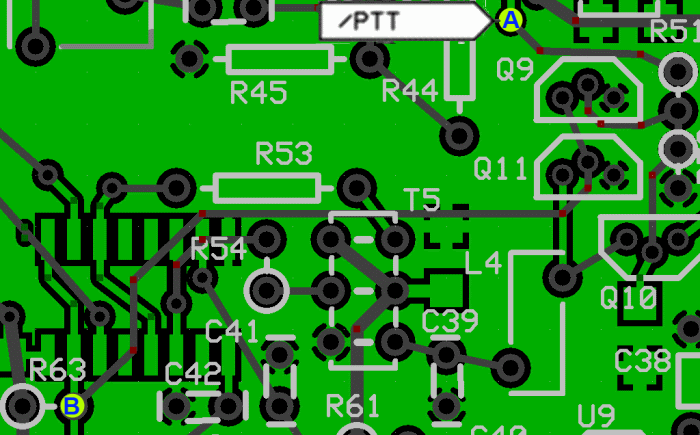
Test Measurements
| Testpoint | Units | Nominal Value | Author's | Yours |
|---|---|---|---|---|
| Default (RX Activated): Point A | Vdc | High (9 - 12 Vdc) | 9.86 | _______ |
| Default (RX Activated): Point B (R63 hairpin) | Vdc | Low (~ 0) | 0 | _______ |
| PTT Activated: Point A | Vdc | Low (~ 0) | 0 | _______ |
| PTT Activated: Point B | Vdc | High (~ 5) | 4.95 | _______ |
RF Path Testing
Test Setup
There are two approaches to testing the RF Path. One involves testing for continuity through the switching transistors. This approach calls for testing continuity with the board powered up, something which some are understanably uncomfortable doing. As Bob, G8VOI puts it:
"Personally that is one particular test which I have severe reservations about, and think it might well contribute to a number of the failures of FETs that some people have experienced in that area.
I suspect it might depend on the terminal voltage of the meter being used, polarity, or simply slipping and shorting to something else.
I think it is sufficient just to measure the voltage on the junction of R51 / R50, i.e the gate of Q10 when the PTT is active, should be around 8V which will turn Q10 on.
Most people have successfully carried out that test as described in Robby's notes without any ill effects, but there have also been a number of unexplained failures of Q10 and Q9.
I could be totally wrong of course :)
The other approach is, as Bob suggests, simply testing that Q10 is getting the proper voltage to switch it ON.
Which approach is selected is up to the builder.
Continuity Test Under PowerApproach
Using your ohmmeter, test for continuity along the RF path for the RX. The path can be tested between C27 (bottom pin - point A) and regular ground (hiarpin lead of R50).
.You must have the USB powered up and the board's 12V power applied to test the path from C27 (point A) through to the other (ground) end of T5 (ground, point B).
Note: the testpoint "A", shown on the graphic, MUST be POSITIVE with respect to test point "B" in order to correctly assess the continuity from A to B. Normally, the positive lead will be the red lead of your ohmmeter. If you get an OPEN reading, try reversing the leads of your ohmmeter..
Q10 Voltage Approach
With power applied (USB and regular 12V), measure the voltage at the junction of R51 and R50 (hairpin of R51). It should be approximately 8V
Additional Voltage Tests
For a more thorough test of the voltages for switching for RX and/or TX, refer to this page courtesy of Bob, G8VOI.
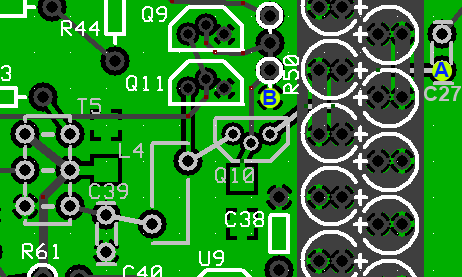
Test Measurements
| Testpoint | Units | Nominal Value | Author's | Yours |
|---|---|---|---|---|
| Continuity from Point A to Point B | ohm | 0 | 0 | _______ |
| Hairpin of R51 (Q10 switching voltage | Vdc | ~8 | 8.04 | _______ |











